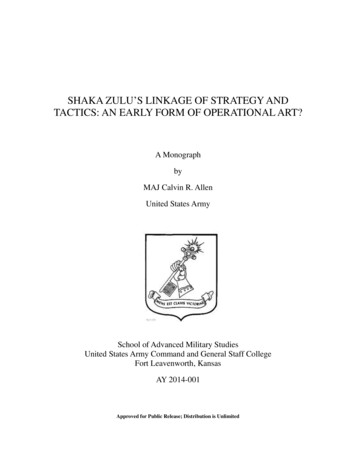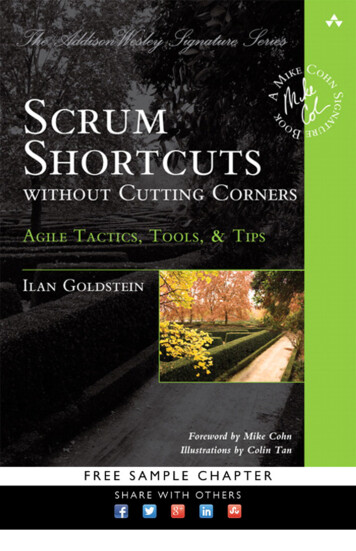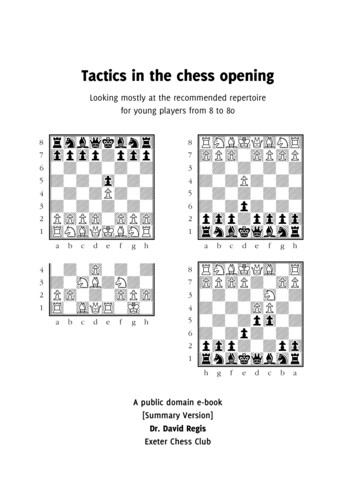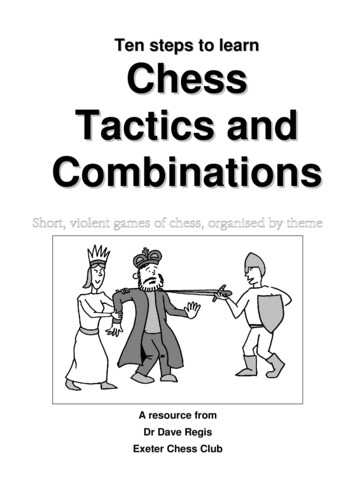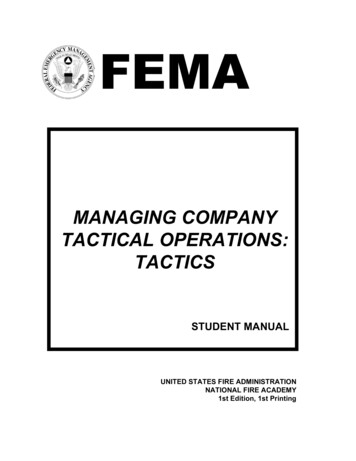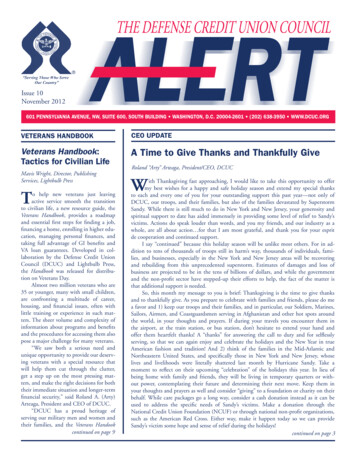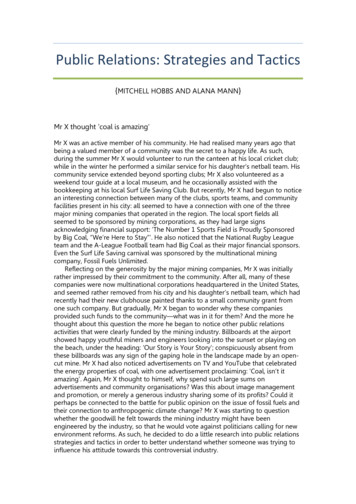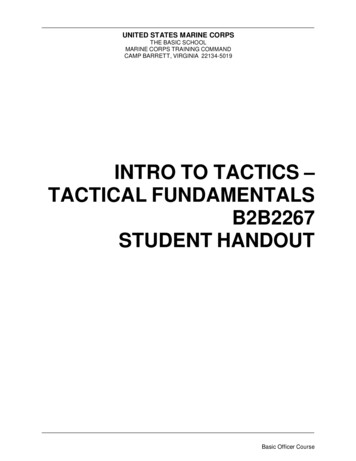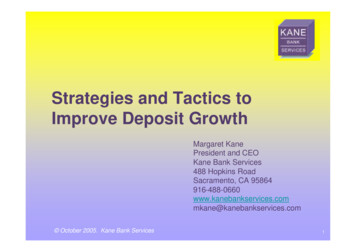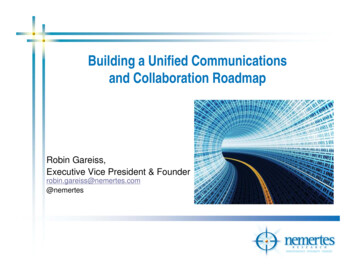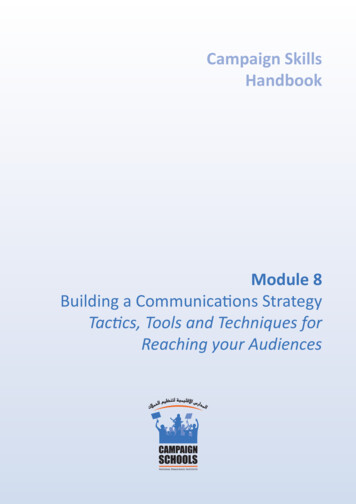
Transcription
Campaign SkillsHandbookModule 8Building a Communications StrategyTactics, Tools and Techniques forReaching your Audiences
IntroductionCommunicating to voters and potential supporters through the media is a challengefor every campaign, especially in areas where the media might be controlled by otherparties or interests. But working strategically with the media can really pay off for yourcampaign, allowing you to reach more voters and persuade them with your message.A strategic communications plan will help ensure that you are maximizing everyopportunity to inform, inspire and motivate your supporters through the media. Thismodule covers the tools and skills needed to build this communications plan, whichwill attract attention to your campaign from both traditional (television, radio andnewspaper) and new (Internet, blogs and social media) media. Topics covered include:1.2.3.4.5.Developing a Strategic Communications PlanWorking with the MediaOrganizing Effective Media EventsThe Media ToolkitNew Media CommunicationsModule 8: Building a Communications Strategy1
Developing a Strategic Communications PlanA strategic communications plan, or media strategy, is your plan for getting positivecoverage of your campaign through the media that your target voters use the most,in order to communicate your message to these voters. Political campaigns benefitgreatly from a well-run media outreach program.There are a number of important distinctions to make as you begin to define yourstrategic communications plan. A list of terms frequently used in media planning isoutlined below:MediaAny means of communication designed to deliver information and influence large audiences.This includes newspapers, television, radio, social networking sites, etc.Print MediaMedia that uses the written word on paper, such as newspapers and magazines.Broadcast MediaMedia that broadcasts sounds or images, such as radio and television.Traditional MediaMeans of mass communication introduced and used before the advent of the Internet,including television, radio, newspapers and magazines.New MediaA general term used to describe forms of electronic communication made possible throughcomputer and digital technology, including websites, social networking, video and audiostreaming, online communities and chat rooms, blogs, etc.Earned MediaMedia coverage your campaign or political party gets for free when the media cover yourevents or other efforts.Paid MediaMedia coverage your campaign or political party has to pay for by purchasing advertisingtime or space.2Module 8: Building a Communications Strategy
The media represents a campaign’s best opportunity to be in touch with its intendedaudience on a large scale. Each of the various aspects of media outlined in the tableabove will play a role in your strategic communications plan to a different degreedepending on the local environment and what you want to achieve.However, most campaigns have to rely more on earned media than paid media forfinancial reasons. In this situation, your campaign is in less control of how muchcoverage it will get as well as how it is represented in the media. One of the mainpurposes of constructing a media strategy is to ensure that the message that appearsin the newspapers, on the news or in a blog is the one that you want your targetaudience to see and hear.Your strategy should seek to maximize your media opportunities, but it should alsosupport your campaign’s overall goals and work in partnership with all other parts ofyour campaign, such as voter contact and fundraising. For example, your efforts toconnect with voters and grow grassroots support for your campaign are good newsstories, so your communications strategy should operate in collaboration with theseefforts rather than in isolation.The steps involved in developing a strategic communications plan are similar to thosefor other aspects of campaign planning. They are to:1.2.3.4.Determine your objective(s);define your key audiences;Identify the most important media outlets for your campaign; and,Create a tactical outreach plan of events and activities designed to generate thecoverage you want and on the platforms you need in order to reach your keyaudiences.Throughout this discussion of communication strategies, it is vital to keep in mind thatnone of these efforts will be effective until you have defined your campaign’s coremessages for your target audiences. Unless you know what you are going to say toyour voters and which voters you need to reach, there is no point trying to get mediacoverage. Media coverage without a clear message risks confusing voters, representingyour campaign poorly or even alienating voters. Module 6 of this program offers anumber of tools for developing messages for target audiences.To complete each of the steps for developing an effective communication strategy,think through the questions below. Many of these build on the work done in previousmodules on targeting, research and analysis.Module 8: Building a Communications Strategy3
1.What is our objective? What do we want to achieve?Like all aspects of your campaign, putting together a solid media strategy startswith thinking through what it is you want or need to achieve. What is the sizeof the audience you are trying to persuade? Is it large, manageable or small? Ismedia the best way to reach them, or is direct voter contact going to be moreeffective?What about the image or profile of the political party or any candidates? Do thevoters know enough about your party or candidates? Do the voters like yourparty or candidates? Are there any policy ideas or issues you need to advanceto change the terms of the debate around an election? What do you need thevoters to know about your campaign and is the media the best way of helping tocommunicate this information?Define clearly what it is you need to achieve through your media strategy. Returnto your SWOT analysis from Module 3 of this program to review your challengesand opportunities in this campaign.2.Who is the campaign’s target audience?Defining your media strategy requires an assessment of your targeted voters andthe media landscape in the area. Who are the people with whom your campaignis trying to communicate?To answer this question, return to the voter targeting you conducted earlier inyour campaign planning from Module 3 of this program. Your research shouldhave given you information about who your core supporters are, and who theundecided or persuadable voters are, that you need to communicate with inorder to achieve your goals. Think through the types of people you need to reachand what their access to information must be like. Use the persona profiles youconstructed in Module 6 of this program to help you visualize this.3.Which media outlets do our target audience(s) rely on for information? Whatare the most important media outlets to the campaign?Think about how each group of your campaign’s targeted voters get theirinformation. What media outlets do they rely on and use regularly? Considerall forms of media, both traditional and new, and whether infrastructure (forexample, regular electricity or Internet service) will affect their access to variousoutlets.4Module 8: Building a Communications Strategy
There are a number of ways you can research this if the answer is not readilyapparent. Ask a local advertising agency or the sales departments of the mediaoutlets themselves. Public opinion polls also frequently ask voters where they gettheir information. You can also ask targeted voters directly as part of a campaignsurvey canvass about what issues they care about most.In the Middle East and North Africa, most voters get most of their informationfrom watching television. But it’s not always easy to get television coverage forcampaign events, so consider what other media outlets your targeted votersrely on for information. Are there special media outlets that reach certaingroups of voters, such as minority groups, students, or people living in certainneighborhoods or remote areas? Do groups such as young people or womenconsume media differently?Once you know how your target audiences get their information, single out theones on which your campaign can actually get coverage. These outlets becomepriorities for your media outreach strategy.As an example, one campaign might target the large, commercial televisionstations in the area, because most voters in their target groups watch a lot oftelevision and these companies are likely to give some form of coverage to allparties. Another campaign may recognize that they are unlikely to get televisioncoverage because the station’s owners support a different party, or because thesestations are unlikely to consider the campaign a priority. In this situation, thecampaign might focus on a combination of newspapers, radio, and new mediainstead.Make a list of your priority media outlets, and then add secondary outlets. Yoursecondary outlets are those you can access more easily or less expensively, andtypically include new media such as video streaming or social media sites. Whileyour focus will be on your priority outlets, it is important to include secondaryoutlets in your strategy as well. Many reporters working with larger mediasources pay attention to news coverage on a wide variety of outlets, includinglocal blogs, social media sites and stories reported through other media, and maypick up your message this way.Finally, consider the relationships you have with the media outlets you haveidentified as a priority. What specific steps can you take to improve yourcommunication with these media and build your professional networks with keyjournalists and news editors?Module 8: Building a Communications Strategy5
4.What strategies and tactics will your campaign use to get your priority mediaoutlets to deliver your message to your targeted voters?Strategies and tactics are the specific actions your campaign takes to actually gainmedia coverage, particularly earned media. What are some possible campaignevents that your campaign could organize that would advance your message,keep your supporters engaged, and be interesting enough to appeal to the newsmedia?First, consider the type of media you have prioritized. Newspaper, radio andblogs are less visual and will require events that focus more on storytelling. Mostother media are much more visual and will require good backdrops and settingsor engaging images for broadcast. On almost every occasion, party leadersor candidates simply sitting at a table talking will not fulfill your objectives ofengaging your target voters and keeping them interested. It’s too dull.There are number of ways to come up with ideas for campaign events that arenewsworthy:6a.Write down the stories your campaign is trying to tell voters in order toconvey your message. Are there ways to tell these stories through events?For example, if your campaign message focuses on jobs, can you organizeevents that highlight both the human impact of this problem and yourcampaign’s proposed solutions?b.Conceptualize the visual images tied to your message. If it’s about educationor the future of young people, can you create an event with children andyoung people at a school that would create a great visual for the media tocover? If it’s about the economy, can you create an event with street vendors,factory workers, young people who are out of work, or enlist a successfullocal enterprise to help paint a picture associated with your message?c.Think about how your campaign can look bigger. Are there endorsements,debates, rallies or large public events that would help create the image oflarge amounts of growing support for your campaign?d.Come up with ideal headlines. If you were writing the headlines for the presscoverage of your campaign, what would you want them to say about yourpolicies, your relationship with voters, your integrity, your commitment topublic service, or your vision for the country? Write down these headlinesand then construct communication events that could get you there.Module 8: Building a Communications Strategy
e.Take advantage of campaign milestones to attract coverage. Milestonesare events that receive special attention because they are connected tokey occurrences during the campaign or to something that measures yoursuccess. For example, filing candidate registration papers with lots ofsignatures of support or receiving endorsements from important communityleaders show that your campaign is competitive and newsworthy.Typical milestone events include:Announcing your candidacyReceiving endorsements from opinion leaders, organizations or news outletsReaching fundraising goalsMeeting party registration deadlinesInitiating advertising or social media activitiesLaunching policies, platforms or manifestosCanvassing and other major campaign volunteer activitiesHosting voter registration drivesPlot these events on a calendar and use them as occasions to getcoverage from both traditional and new media.Activity 1: Strategic Communications PlanningEstablish the goal for your communications plan. What is it you need to achieve?If it is helpful, return to your SWOT analysis from Module 3 of this program toreview your challenges and opportunities in this campaign and to help you thinkthrough what you need to accomplish through your media communications.1.2.Think about your target audiences and where they get their information. In thetable below, identify each group you will have to communicate with and list themedia outlets they rely on for information.Targeted Voter GroupKey Media Outlets for This GroupModule 8: Building a Communications Strategy7
3.From the list above, write down your priority media outlets that your campaignwill target for coverage. These are the media outlets your target voters use themost. Then, see if you can come up with secondary media outlets. These areoutlets you can access more easily or less expensively wh
Media that uses the written word on paper, such as newspapers and magazines. Media that broadcasts sounds or images, such as radio and television. Means of mass communication introduced and used before the advent of the Internet, including television, radio, newspapers and magazines. A general term used to describe forms of electronic communication made possible through computer and digital .
